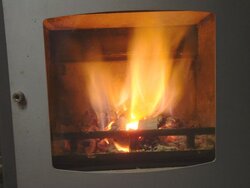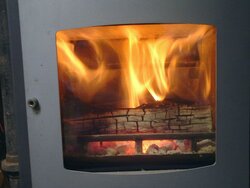The facts:
1. Wood is mixture of maple/oak/black birch c/s/s 2+ years, don't have a moisture meter but I'm pretty confident it's dry. I can give more details on the wood if needed.
2. Stove is PE Summit Classic bought & installed new with OAK (Outside Air Kit).
3. Burner is a newbie, just about burnt my first cord up
4. Ran the first 3 weeks or so without emptying the ash, no buildup to mention.
5. About a week or so I noticed the charcoal was building up (not ash) and about 2-3 days later stove was 50% charcoal - like at least 3-4 gallons worth. This wasn't happening to me before.
6. When it hit 50% charcoal I didn't worry about it too much, tried to burn it down unsuccessfully and just emptied it.
7. Stove has an ash pan, haven't used it, it's empty. Do need to figure it out...
Since this happened, which was about Tuesday or Wednesday it has already happened again. Last night I loaded it up (what I could, because so much charcoal) and went to bed with the air 100% open. I figured that would burn the charcoal down. Got about at 5AM and didn't really have any luck. The charcoal didn't seem to decrease.
I'm trying everything to burn down the charcoal, low air, high air, open door, paper with no wood and it doesn't seem to be decreasing.
Right now I have no wood in it, through some paper and lighter fluid in it and left the door open. I'm at a loss for what I am doing wrong here.
Any help would be greatly appreciated!
1. Wood is mixture of maple/oak/black birch c/s/s 2+ years, don't have a moisture meter but I'm pretty confident it's dry. I can give more details on the wood if needed.
2. Stove is PE Summit Classic bought & installed new with OAK (Outside Air Kit).
3. Burner is a newbie, just about burnt my first cord up
4. Ran the first 3 weeks or so without emptying the ash, no buildup to mention.
5. About a week or so I noticed the charcoal was building up (not ash) and about 2-3 days later stove was 50% charcoal - like at least 3-4 gallons worth. This wasn't happening to me before.
6. When it hit 50% charcoal I didn't worry about it too much, tried to burn it down unsuccessfully and just emptied it.
7. Stove has an ash pan, haven't used it, it's empty. Do need to figure it out...
Since this happened, which was about Tuesday or Wednesday it has already happened again. Last night I loaded it up (what I could, because so much charcoal) and went to bed with the air 100% open. I figured that would burn the charcoal down. Got about at 5AM and didn't really have any luck. The charcoal didn't seem to decrease.
I'm trying everything to burn down the charcoal, low air, high air, open door, paper with no wood and it doesn't seem to be decreasing.
Right now I have no wood in it, through some paper and lighter fluid in it and left the door open. I'm at a loss for what I am doing wrong here.
Any help would be greatly appreciated!


 John_M
John_M Methinks you are a very lucky man to be able to post this after some things you've done. But to start from the beginning:
Methinks you are a very lucky man to be able to post this after some things you've done. But to start from the beginning:

